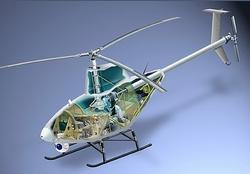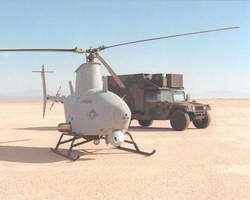Thu, Feb 13, 2003
 Northrop Grumman Corporation's Integrated Systems
sector continued its successful envelope expansion of the US Navy
Fire Scout vertical takeoff and landing tactical unmanned system
with a four-hour mission Feb. 8, the longest flight test to date.
Northrop Grumman now has conducted more than 35 flights in the
ongoing test demonstrations since May 2002. The latest mission
demonstrated fully autonomous operations from engine start through
takeoff, waypoint navigation, approach and landing, followed by
engine shutdown. Flights are conducted at the Webster Field annex
of Naval Air Station Patuxent River, Md.
Northrop Grumman Corporation's Integrated Systems
sector continued its successful envelope expansion of the US Navy
Fire Scout vertical takeoff and landing tactical unmanned system
with a four-hour mission Feb. 8, the longest flight test to date.
Northrop Grumman now has conducted more than 35 flights in the
ongoing test demonstrations since May 2002. The latest mission
demonstrated fully autonomous operations from engine start through
takeoff, waypoint navigation, approach and landing, followed by
engine shutdown. Flights are conducted at the Webster Field annex
of Naval Air Station Patuxent River, Md.
During the mission, which was operated from the Navy ground
control station, the tactical control datalink was used to uplink
payload command and control and to downlink imagery. The ARC-210
datalink was used for air vehicle command and control. The ability
of the operator to redirect the air vehicle in flight also was
demonstrated as planned. Throughout the mission, the Fire Scout air
vehicle successfully demonstrated three loiter patterns, 20 loiters
and 60 waypoints under autonomous navigation.

The Fire Scout payload, supplied by Northrop Grumman's
Electronic Systems sector, Baltimore, Md., operated throughout the
mission. The payload consists of electro-optical and infrared
sensors and a laser designator/rangefinder, which provide
intelligence, surveillance and reconnaissance imagery and data.
 The Fire Scout's communications suite is designed
to allow simultaneous voice/data relay much farther than the "line
of sight" limits of current systems. This communications relay
suite is part of the standard air vehicle configuration, and does
not reduce the available capacity for primary mission payloads.
The Fire Scout's communications suite is designed
to allow simultaneous voice/data relay much farther than the "line
of sight" limits of current systems. This communications relay
suite is part of the standard air vehicle configuration, and does
not reduce the available capacity for primary mission payloads.
The Fire Scout system is in development and low-rate initial
production by Northrop Grumman as a force multiplier for Navy
forces at sea and Marine Corps forces ashore. Fire Scout can
operate up to 20,000 feet, above deployed Marines and provide the
capability to watch for threats within 150 nautical miles of the
ground control station. The system can direct Navy and Marine
weapons accurately to the target with precise target location
coordinates or the laser designator.
More News
Aero Linx: Model Aeronautical Association of Australia MAAA clubs are about fun flying, camaraderie and community. For over 75 years, the MAAA has been Australia’s largest fl>[...]
Touchdown Zone Lighting Two rows of transverse light bars located symmetrically about the runway centerline normally at 100 foot intervals. The basic system extends 3,000 feet alon>[...]
“Discovery and innovation are central to our mission at Virgin Galactic. We’re excited to build on our successful record of facilitating scientific experiments in subor>[...]
How To Get A Story On Aero-TV News/Feature Programming How do I submit a story idea or lead to Aero-TV? If you would like to submit a story idea or lead, please contact Jim Campbel>[...]
Student Pilot Reported That During Rotation, “All Of A Sudden The Back Of The Plane Kicked To The Right..." Analysis: The student pilot reported that during rotation, “>[...]
 ANN's Daily Aero-Linx (05.02.24)
ANN's Daily Aero-Linx (05.02.24) ANN's Daily Aero-Term (05.02.24): Touchdown Zone Lighting
ANN's Daily Aero-Term (05.02.24): Touchdown Zone Lighting Aero-News: Quote of the Day (05.02.24)
Aero-News: Quote of the Day (05.02.24) ANN FAQ: Contributing To Aero-TV
ANN FAQ: Contributing To Aero-TV NTSB Final Report: Cirrus Design Corp SR20
NTSB Final Report: Cirrus Design Corp SR20





